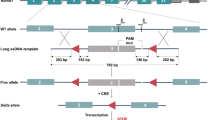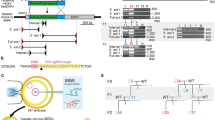Abstract
Homosomic mice of the A/J-7SM consomic mouse strain that introduced the entire chromosome 7 (Chr 7) of SM/J into the A/J strain exhibited neonatal lethality. We tentatively maintained segregating inbred strains (A/J-7ASM and A/J-7DSM) in which the central portion of Chr 7 was heterozygous for the A/J and SM/J strains, and the centromeric and telomeric sides of Chr 7 were homozygous for the SM/J strain, instead of the A/J-7SM strain. Based on the chromosomal constitution of Chr 7 in A/J-7ASM and A/J-7DSM mice, the causative gene for neonatal lethality in homosomic mice was suggested to be located within an approximately 1.620 Mb region between D7Mit125 (104.879 Mb) and D7Mit355 (106.499 Mb) on Chr 7. RT-PCR analysis revealed that homosomic mice lacked dachsous cadherin-related 1 (Dchs1), which is located within the D7Mit125 to D7Mit355 region and functions in the regulation of planar cell polarity. Screening for mutations in Dchs1 indicated that homosomic mice possessed an early transposable (ETn)-like sequence in intron 1 of Dchs1. Moreover, an allelism test between Dchs1 ETn-like-insertion alleles detected in homosomic mice and CRISPR/Cas9-induced Dchs1 deletion alleles revealed that Dchs1 is a causative gene for neonatal lethality in homosomic mice. Based on these results, we concluded that in the A/J-7SM strain, ETn-like elements were inserted into intron 1 of SM/J-derived Dchs1 during strain development, which dramatically reduced Dchs1 expression, thus resulting in neonatal lethality in homosomic mice. Additionally, it was suggested that the timing of lethality in Dchs1 mutant mice is influenced by the genetic background.





Similar content being viewed by others
Data availability
The datasets generated and/or analyzed during the current study are available from the corresponding author on reasonable request.
References
Aida T, Chiyo K, Usami T, Ishikubo H, Imahashi R, Wada Y, Tanaka KF, Sakuma T, Yamamoto T, Tanaka K (2015) Cloning-free CRISPR/Cas system facilitates functional cassette knock-in mice. Genome Biol 16:87. https://doi.org/10.1186/s13059-015-0653-x
Baust C, Gagnier L, Baillie GJ, Harris MJ, Juriloff DM, Mager DL (2003) Structure and expression of mobile ETnII retroelements and their coding-competent MusD relatives in the mouse. J Virol 77:11448–11458. https://doi.org/10.1128/jvi.77.21.11448-11458.2003
Cappello S, Gray MJ, Badouel C, Lange S, Einsiedler M, Srour M, Chitayat D, Hamdan FF, Jenkins ZA, Morgan T, Preitner N, Uster T, Thomas J, Shannon P, Morrison V, Di Donato N, Van Maldergem L, Neuhann T, Newbury-Ecob R, Swinkells M, Terhal P, Wilson LC, Zwijnenburg PJ, Sutherland-Smith AJ, Black MA, Markie D, Michaud JL, Simpson MA, Mansour S, McNeill H, Götz M, Robertson SP (2013) Mutations in genes encoding the cadherin receptor-ligand pair DCHS1 and FAT4 disrupt cerebral cortical development. Nat Genet 45:1300–1308. https://doi.org/10.1038/ng.2765
DeFries JC, Wilson JR, Erwin VG, Petersen DR (1989) LS X SS recombinant inbred strains of mice: initial characterization. Alcohol Clin Exp Res 13:196–200. https://doi.org/10.1111/j.1530-0277.1989.tb00310.x
Dewannieux M, Ribet D, Heidmann T (2010) Risks linked to endogenous retroviruses for vaccine production: a general overview. Biologicals 38:366–370. https://doi.org/10.1016/j.biologicals.2010.01.006
Flint J, Eskin E (2012) Genome-wide association studies in mice. Nat Rev Genet 13:807–817. https://doi.org/10.1038/nrg3335
Hada N, Kobayashi M, Fujiyoshi M, Ishikawa A, Kuga M, Nishimura M, Ebihara S, Ohno T, Horio F (2008) Quantitative trait loci for impaired glucose tolerance in nondiabetic SM/J and A/J mice. Physiol Genomics 35:65–74. https://doi.org/10.1152/physiolgenomics.00027.2008
Haeussler M, Schönig K, Eckert H, Eschstruth A, Mianné J, Renaud JB, Schneider-Maunoury S, Shkumatava A, Teboul L, Kent J, Joly JS, Concordet JP (2016) Evaluation of off-target and on-target scoring algorithms and integration into the guide RNA selection tool CRISPOR. Genome Biol 17:148. https://doi.org/10.1186/s13059-016-1012-2
Hernandez VJ, Weng J, Ly P, Pompey S, Dong H, Mishra L, Schwarz M, Anderson RG, Michaely P (2013) Cavin-3 dictates the balance between ERK and Akt signaling. Elife 2:e00905. https://doi.org/10.7554/eLife.00905
Hua G, Kolesnick R (2013) Using ASMase knockout mice to model human diseases. Handb Exp Pharmacol 216:29–54. https://doi.org/10.1007/978-3-7091-1511-4_2
Kobayashi M, Ohno T, Tsuji A, Nishimura M, Horio F (2003) Combinations of nondiabetic parental genomes elicit impaired glucose tolerance in mouse SMXA recombinant inbred strains. Diabetes 52:180–186. https://doi.org/10.2337/diabetes.52.1.180
Kobayashi M, Ohno T, Kawada T, Ikegami H, Nishimura M, Horio F (2006) Serum adiponectin concentration: its correlation with diabetes-related traits and quantitative trait loci analysis in mouse SMXA recombinant inbred strains. Biosci Biotechnol Biochem 70:677–683. https://doi.org/10.1271/bbb.70.677
Kobayashi M, Ohno T, Hada N, Fujiyoshi M, Kuga M, Nishimura M, Murai A, Horio F (2010) Genetic analysis of abdominal fat distribution in SM/J and A/J mice. J Lipid Res 51:3463–3469. https://doi.org/10.1194/jlr.M009563
Kumazawa M, Kobayashi M, Io F, Kawai T, Nishimura M, Ohno T, Horio F (2007) Searching for genetic factors of fatty liver in SMXA-5 mice by quantitative trait loci analysis under a high-fat diet. J Lipid Res 48:2039–2046. https://doi.org/10.1194/jlr.M700222-JLR200
Kuta A, Mao Y, Martin T, Ferreira de Sousa C, Whiting D, Zakaria S, Crespo-Enriquez I, Evans P, Balczerski B, Mankoo B, Irvine KD, Francis-West PH (2016) Fat4-Dchs1 signalling controls cell proliferation in developing vertebrae. Development 143:2367–2375. https://doi.org/10.1242/dev.131037
Maegawa T, Miyasaka Y, Kobayashi M, Babaya N, Ikegami H, Horio F, Takahashi M, Ohno T (2018) Congenic mapping and candidate gene analysis for streptozotocin-induced diabetes susceptibility locus on mouse chromosome 11. Mamm Genome 29:273–280. https://doi.org/10.1007/s00335-018-9742-y
Maksakova IA, Mager DL (2005) Transcriptional regulation of early transposon elements, an active family of mouse long terminal repeat retrotransposons. J Virol 79:13865–13874. https://doi.org/10.1128/JVI.79.22.13865-13874.2005
Maksakova IA, Romanish MT, Gagnier L, Dunn CA, van de Lagemaat LN, Mager DL (2006) Retroviral elements and their hosts: insertional mutagenesis in the mouse germ line. PLOS Genet. https://doi.org/10.1371/journal.pgen.0020002
Mansour S, Swinkels M, Terhal PA, Wilson LC, Rich P, Van Maldergem L, Zwijnenburg PJ, Hall CM, Robertson SP, Newbury-Ecob R (2012) Van Maldergem syndrome: further characterisation and evidence for neuronal migration abnormalities and autosomal recessive inheritance. Eur J Hum Genet 20:1024–1031. https://doi.org/10.1038/ejhg.2012.57
Mao Y, Mulvaney J, Zakaria S, Yu T, Morgan KM, Allen S, Basson MA, Francis-West P, Irvine KD (2011) Characterization of a Dchs1 mutant mouse reveals requirements for Dchs1-Fat4 signaling during mammalian development. Development 138:947–957. https://doi.org/10.1242/dev.057166
Mohan WS Jr, Scheer E, Wendling O, Metzger D, Tora L (2003) TAF10 (TAF(II)30) is necessary for TFIID stability and early embryogenesis in mice. Mol Cell Biol 23:4307–4318. https://doi.org/10.1128/MCB.23.12.4307-4318.2003
Moriwaki K, Miyashita N, Mita A, Gotoh H, Tsuchiya K, Kato H, Mekada K, Noro C, Oota S, Yoshiki A, Obata Y, Yonekawa H, Shiroishi T (2009) Unique inbred strain MSM/Ms established from the Japanese wild mouse. Exp Anim 58:123–134. https://doi.org/10.1538/expanim.58.123
Murakami S, Suzuki T, Yokoyama W, Yagi S, Matsumura K, Nakajima Y, Harigae H, Fukamizu A, Motohashi H (2018) Nucleomethylin deficiency impairs embryonic erythropoiesis. J Biochem 163:413–423. https://doi.org/10.1093/jb/mvx086
Nadeau JH, Singer JB, Matin A, Lander ES (2000) Analysing complex genetic traits with chromosome substitution strains. Nat Genet 24:221–225. https://doi.org/10.1038/73427
Nesbitt MN, Skamene E (1984) Recombinant inbred mouse strains derived from A/J and C57BL/6J: a tool for the study of genetic mechanisms in host resistance to infection and malignancy. J Leukoc Biol 36:357–364. https://doi.org/10.1002/jlb.36.3.357
Nishimura M, Hirayama N, Serikawa T, Kanehira K, Matsushima Y, Katoh H, Wakana S, Kojima A, Hiai H (1995) The SMXA: a new set of recombinant inbred strain of mice consisting of 26 substrains and their genetic profile. Mamm Genome 6:850–857. https://doi.org/10.1007/BF00292434
O’Connor LT, Goetz BD, Kwiecien JM, Delaney KH, Fletch AL, Duncan ID (1999) Insertion of a retrotransposon in Mbp disrupts mRNA splicing and myelination in a new mutant rat. J Neurosci 19:3404–3413. https://doi.org/10.1523/JNEUROSCI.19-09-03404.1999
Ohno T, Hata K, Baba T, Io F, Kobayashi M, Horio F, Nishimura M (2012) Establishment of consomic strains derived from A/J and SM/J mice for genetic analysis of complex traits. Mamm Genome 23:764–769. https://doi.org/10.1007/s00335-012-9435-x
Ohno T, Okamoto M, Hara T, Hashimoto N, Imaizumi K, Matsushima M, Nishimura M, Shimokata K, Hasegawa Y, Kawabe T (2013) Detection of loci for allergic asthma using SMXA recombinant inbred strains of mice. Immunogenetics 65:17–24. https://doi.org/10.1007/s00251-012-0656-7
Rock R, Schrauth S, Gessler M (2005) Expression of mouse dchs1, fjx1, and fat-j suggests conservation of the planar cell polarity pathway identified in Drosophila. Dev Dyn 234:747–755. https://doi.org/10.1002/dvdy.20515
Sakai T, Li S, Docheva D, Grashoff C, Sakai K, Kostka G, Braun A, Pfeifer A, Yurchenco PD, Fässler R (2003) Integrin-linked kinase (ILK) is required for polarizing the epiblast, cell adhesion, and controlling actin accumulation. Genes Dev 17:926–940. https://doi.org/10.1101/gad.255603
Seyfried TN, Yu RK, Glaser GH (1980) Genetic analysis of audiogenic seizure susceptibility in C57BL/6J X DBA/2J recombinant inbred strains of mice. Genetics 94:701–718. https://doi.org/10.1093/genetics/94.3.701
Singer JB, Hill AE, Burrage LC, Olszens KR, Song J, Justice M, O’Brien WE, Conti DV, Witte JS, Lander ES, Nadeau JH (2004) Genetic dissection of complex traits with chromosome substitution strains of mice. Science 304:445–448. https://doi.org/10.1126/science.1093139
Sleat DE, Wiseman JA, El-Banna M, Kim KH, Mao Q, Price S, Macauley SL, Sidman RL, Shen MM, Zhao Q, Passini MA, Davidson BL, Stewart GR, Lobel P (2004) A mouse model of classical late-infantile neuronal ceroid lipofuscinosis based on targeted disruption of the CLN2 gene results in a loss of tripeptidyl-peptidase I activity and progressive neurodegeneration. J Neurosci 24:9117–9126. https://doi.org/10.1523/JNEUROSCI.2729-04.2004
Takada T, Mita A, Maeno A, Sakai T, Shitara H, Kikkawa Y, Moriwaki K, Yonekawa H, Shiroishi T (2008) Mouse inter-subspecific consomic strains for genetic dissection of quantitative complex traits. Genome Res 18:500–508. https://doi.org/10.1101/gr.7175308
Takashima K, Matsushima M, Hashimoto K, Nose H, Sato M, Hashimoto N, Hasegawa Y, Kawabe T (2014) Protective effects of intratracheally administered quercetin on lipopolysaccharide-induced acute lung injury. Respir Res 15:150. https://doi.org/10.1186/s12931-014-0150-x
Talamas E, Jackson L, Koeberl M, Jackson T, McElwee JL, Hawes NL, Chang B, Jablonski MM, Sidjanin DJ (2006) Early transposable element insertion in intron 9 of the Hsf4 gene results in autosomal recessive cataracts in lop11 and ldis1 mice. Genomics 88:44–51. https://doi.org/10.1016/j.ygeno.2006.02.012
Tanaka S, Mizorogi T, Nishijima K, Kuwahara S, Tsujio M, Aoyama H, Taguchi C, Kobayashi M, Horio F, Ohno T (2009) Body and major organ weights of A/J-Chr 11(SM) consomic mice. Exp Anim 58:357–361. https://doi.org/10.1538/expanim.58.357
Wang H, Yang H, Shivalila CS, Dawlaty MM, Cheng AW, Zhang F, Jaenisch R (2013) One-step generation of mice carrying mutations in multiple genes by CRISPR/Cas-mediated genome engineering. Cell 153:910–918. https://doi.org/10.1016/j.cell.2013.04.025
Watson J, Riblet R, Taylor BA (1977) The response of recombinant inbred strains of mice to bacterial lipopolysaccharides. J Immunol 118:2088–2093
Acknowledgements
We thank the staff of the Division of Experimental Animals at the Nagoya University Graduate School of Medicine for their technical support. We also thank the staff of the Division for Medical Research Engineering at Nagoya University Graduate School of Medicine for their support in the observation of skeletons using an M205FA stereoscopic microscope.
Funding
This work was supported by the Japan Society for the Promotion of Science (JSPS) KAKENHI, the Grant-in-Aid for Exploratory Research (Grant Number 19650105, T. Ohno), and the Nitto Foundation 33rd grant (Y. Miyasaka).
Author information
Authors and Affiliations
Contributions
Conceptualization, YM, and TO; methodology, YM, MK, FH, KH, TK, and TO; resources, YM, and TO; investigation, YM, TK, NG, MK, MK, FH, KH, TK, and TO; formal analysis, YM, and TO; visualization, YM, and TO; writing—original draft, YM; writing—review & editing, TO; supervision, TO; project administration, TO; funding acquisition, YM, and TO.
Corresponding authors
Ethics declarations
Conflict of interest
The authors have no competing interests to declare that are relevant to the content of this article.
Additional information
Publisher's Note
Springer Nature remains neutral with regard to jurisdictional claims in published maps and institutional affiliations.
Supplementary Information
Below is the link to the electronic supplementary material.
Rights and permissions
Springer Nature or its licensor (e.g. a society or other partner) holds exclusive rights to this article under a publishing agreement with the author(s) or other rightsholder(s); author self-archiving of the accepted manuscript version of this article is solely governed by the terms of such publishing agreement and applicable law.
About this article
Cite this article
Miyasaka, Y., Kobayashi, T., Gotoh, N. et al. Neonatal lethality of mouse A/J-7SM consomic strain is caused by an insertion mutation in the Dchs1 gene. Mamm Genome 34, 32–43 (2023). https://doi.org/10.1007/s00335-022-09966-9
Received:
Accepted:
Published:
Issue Date:
DOI: https://doi.org/10.1007/s00335-022-09966-9




